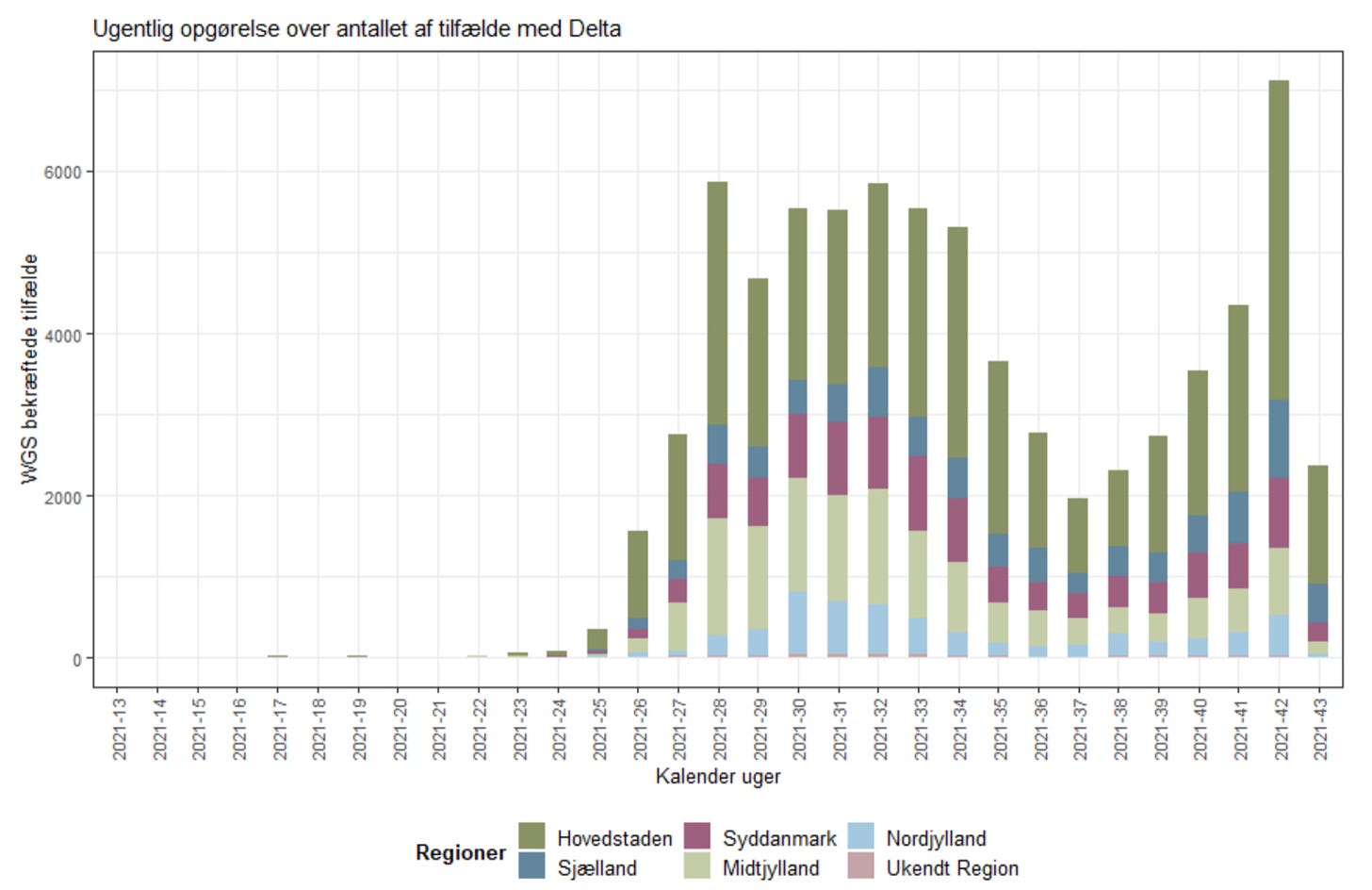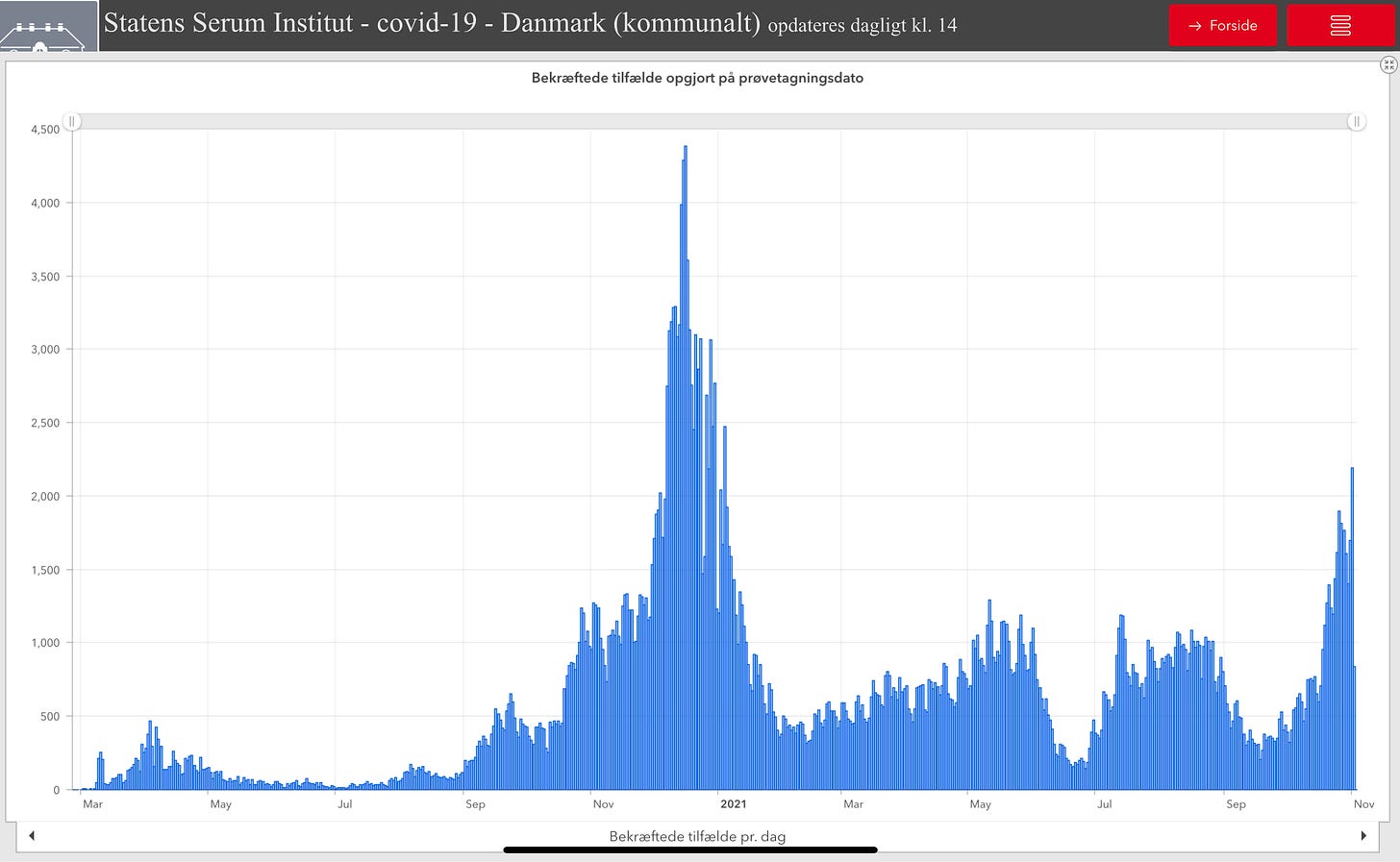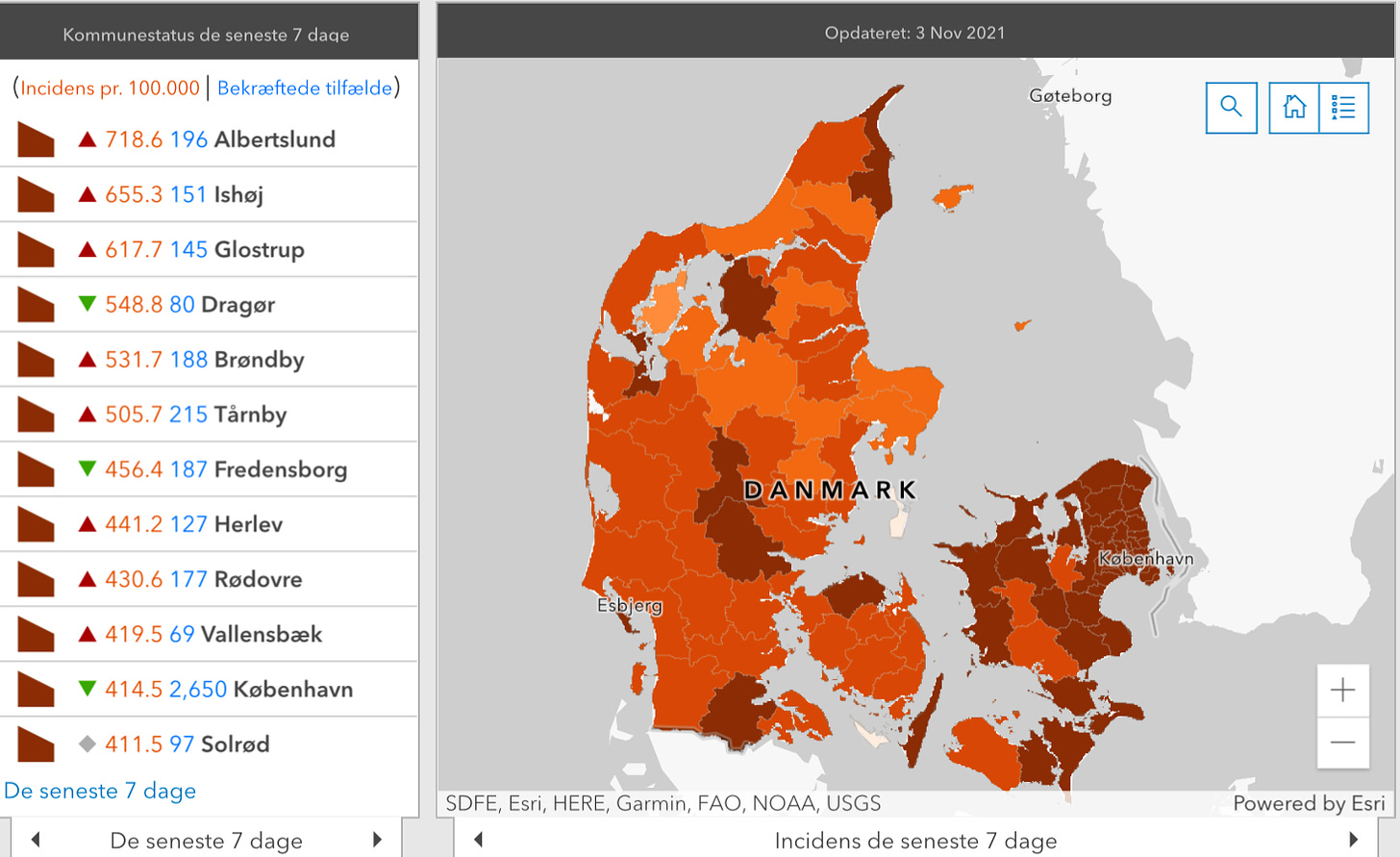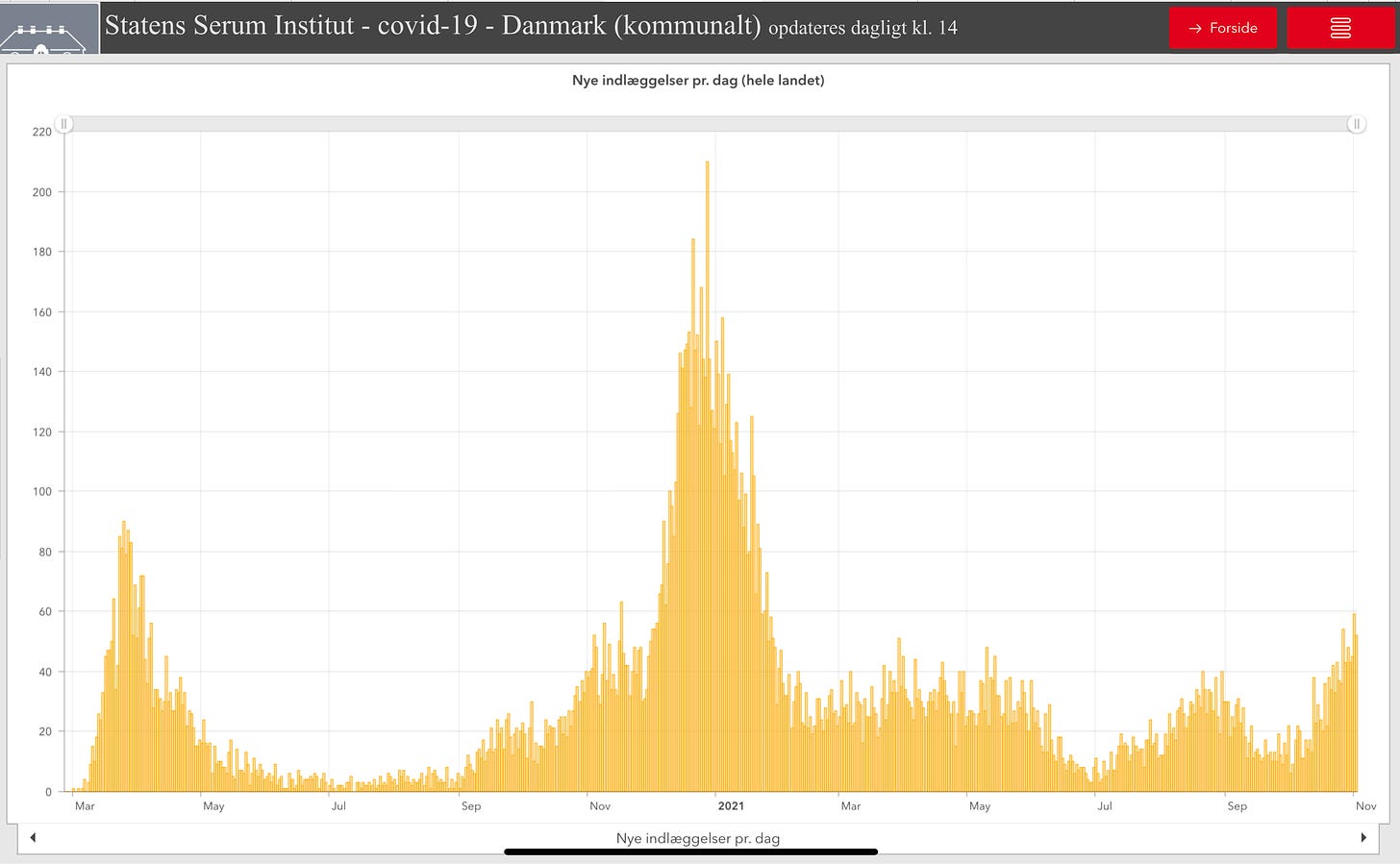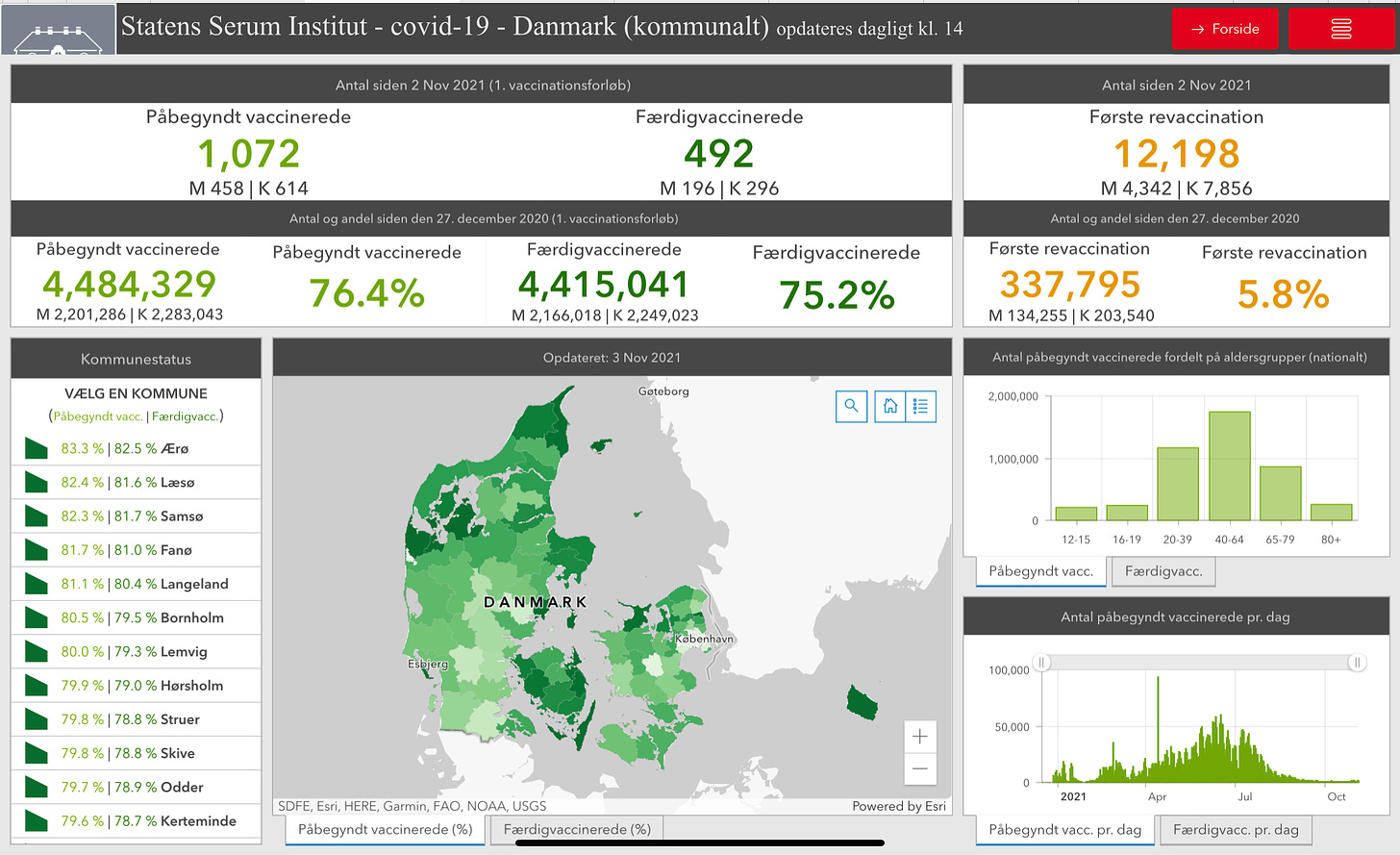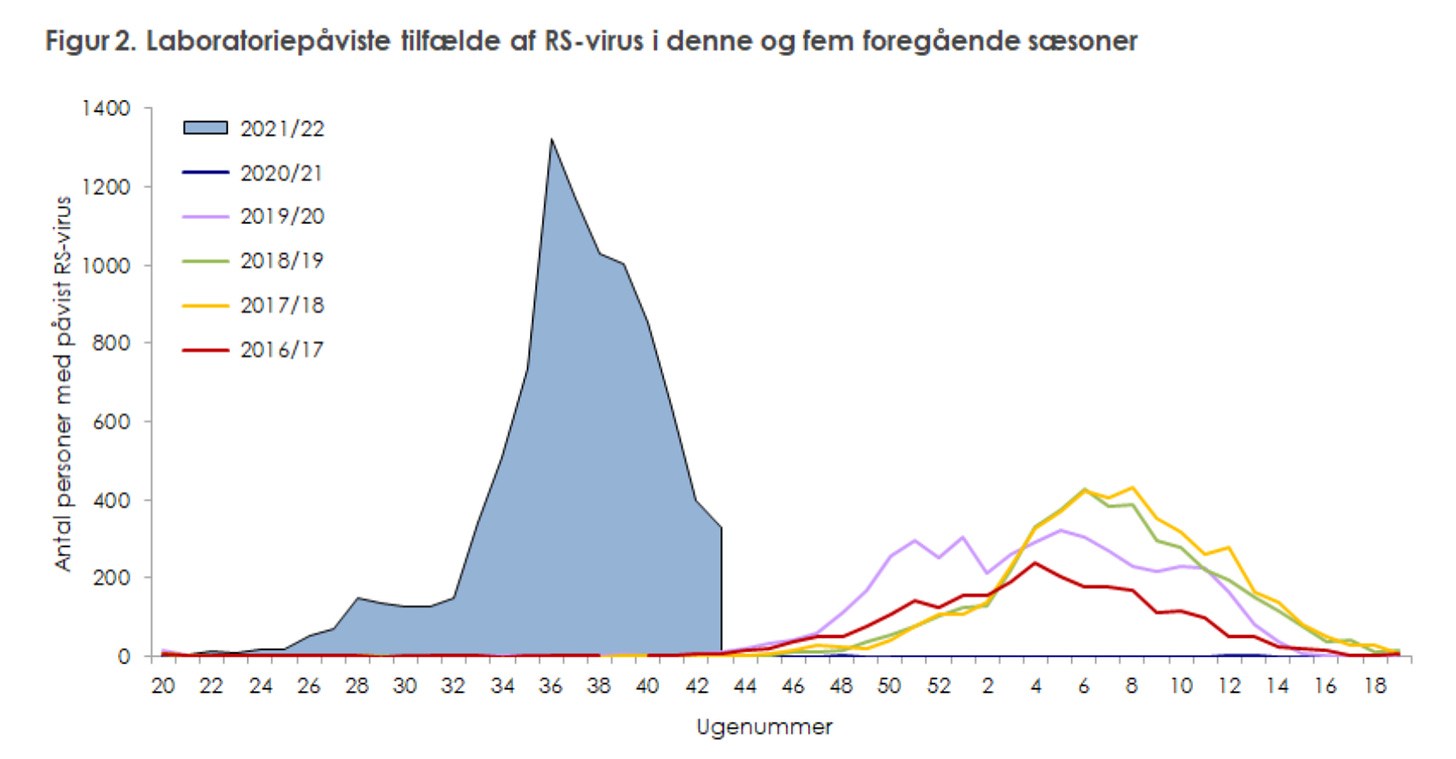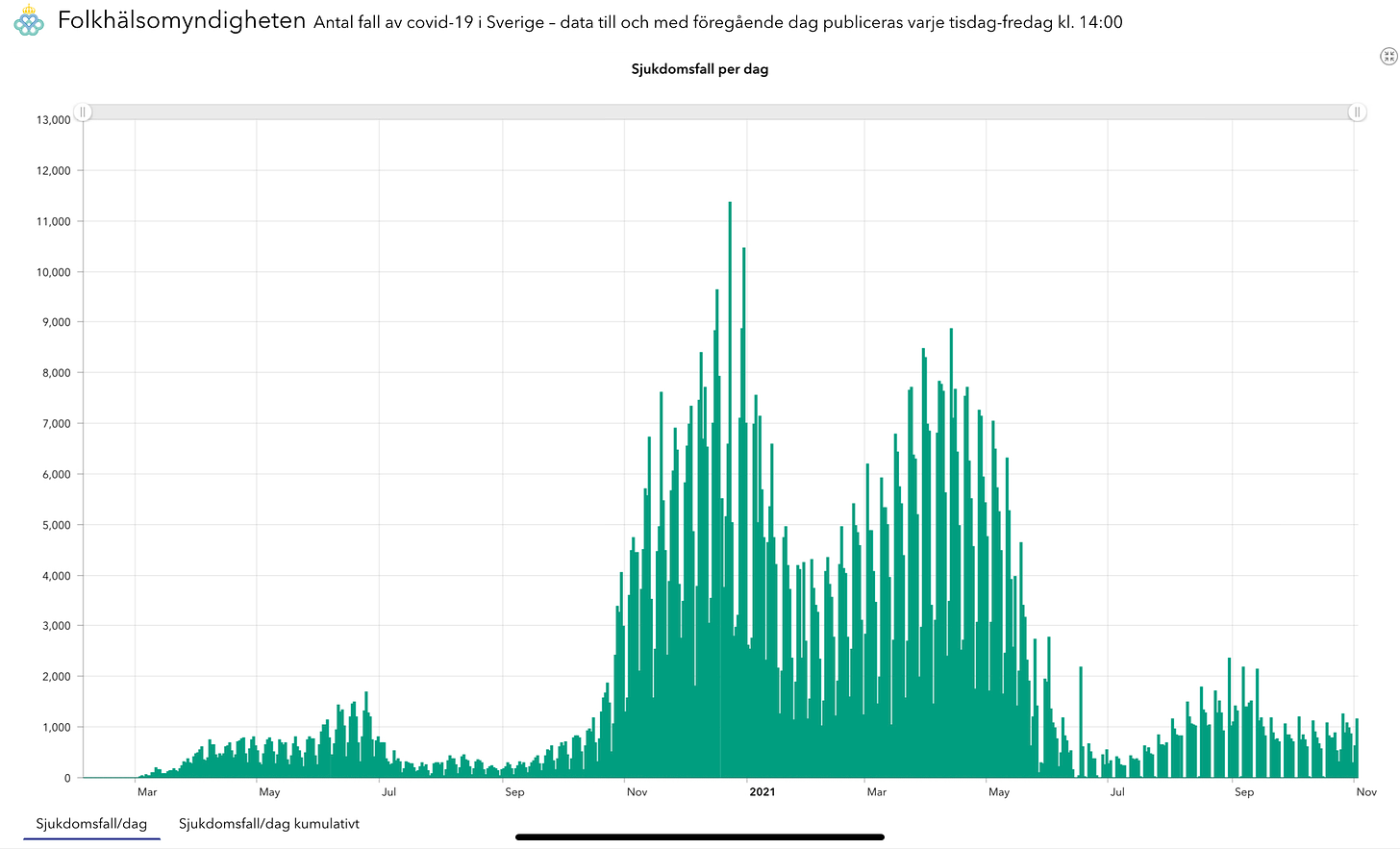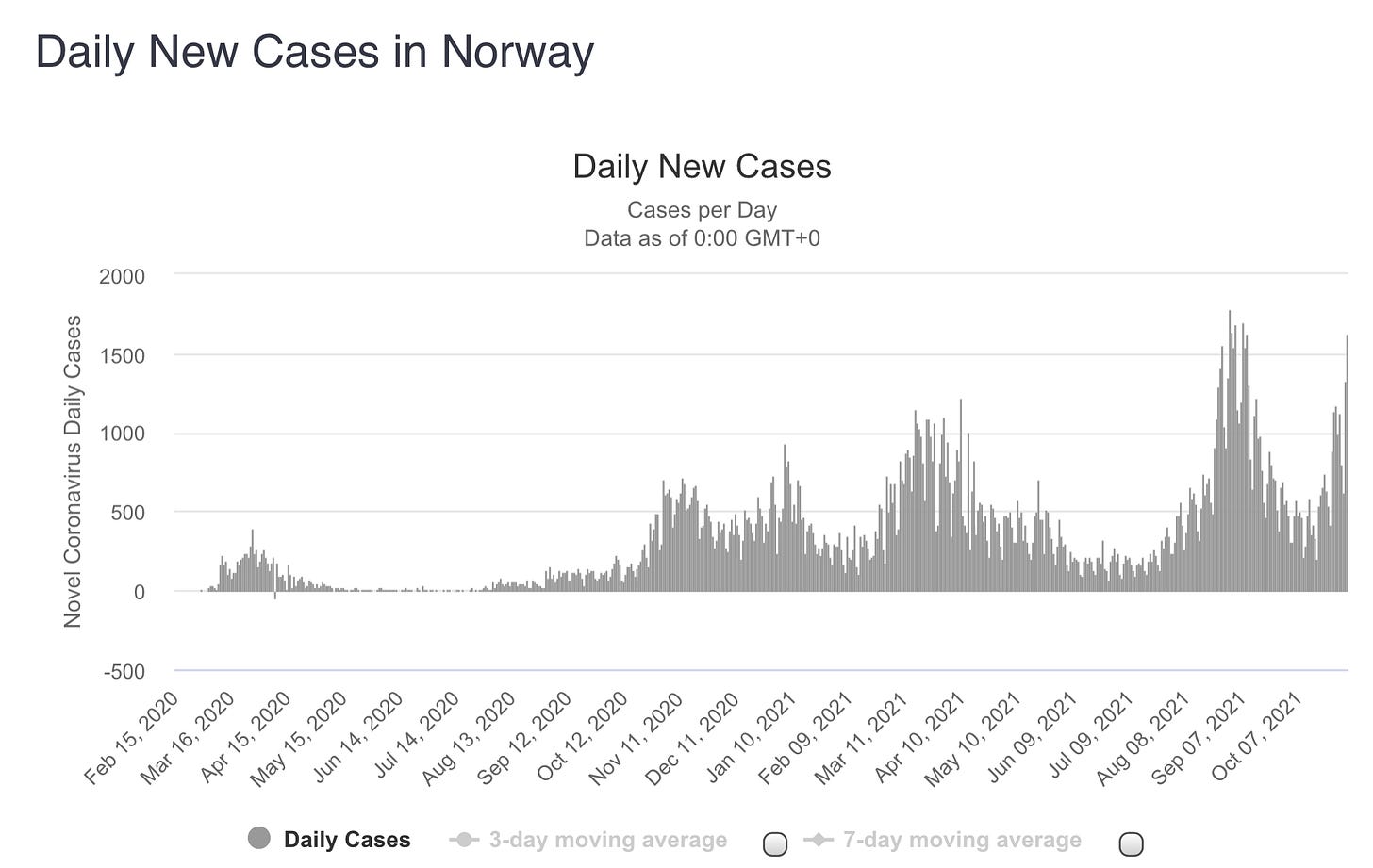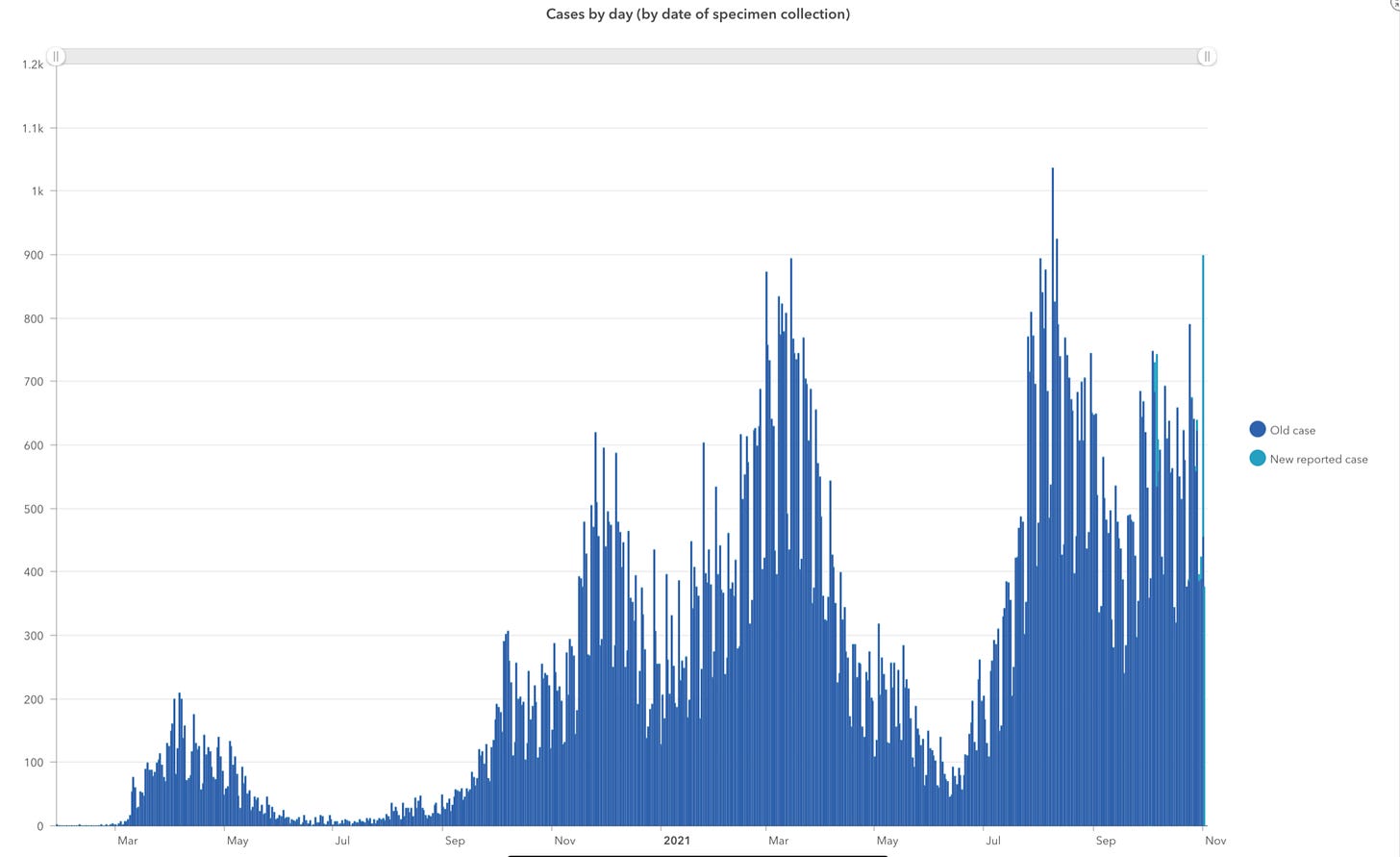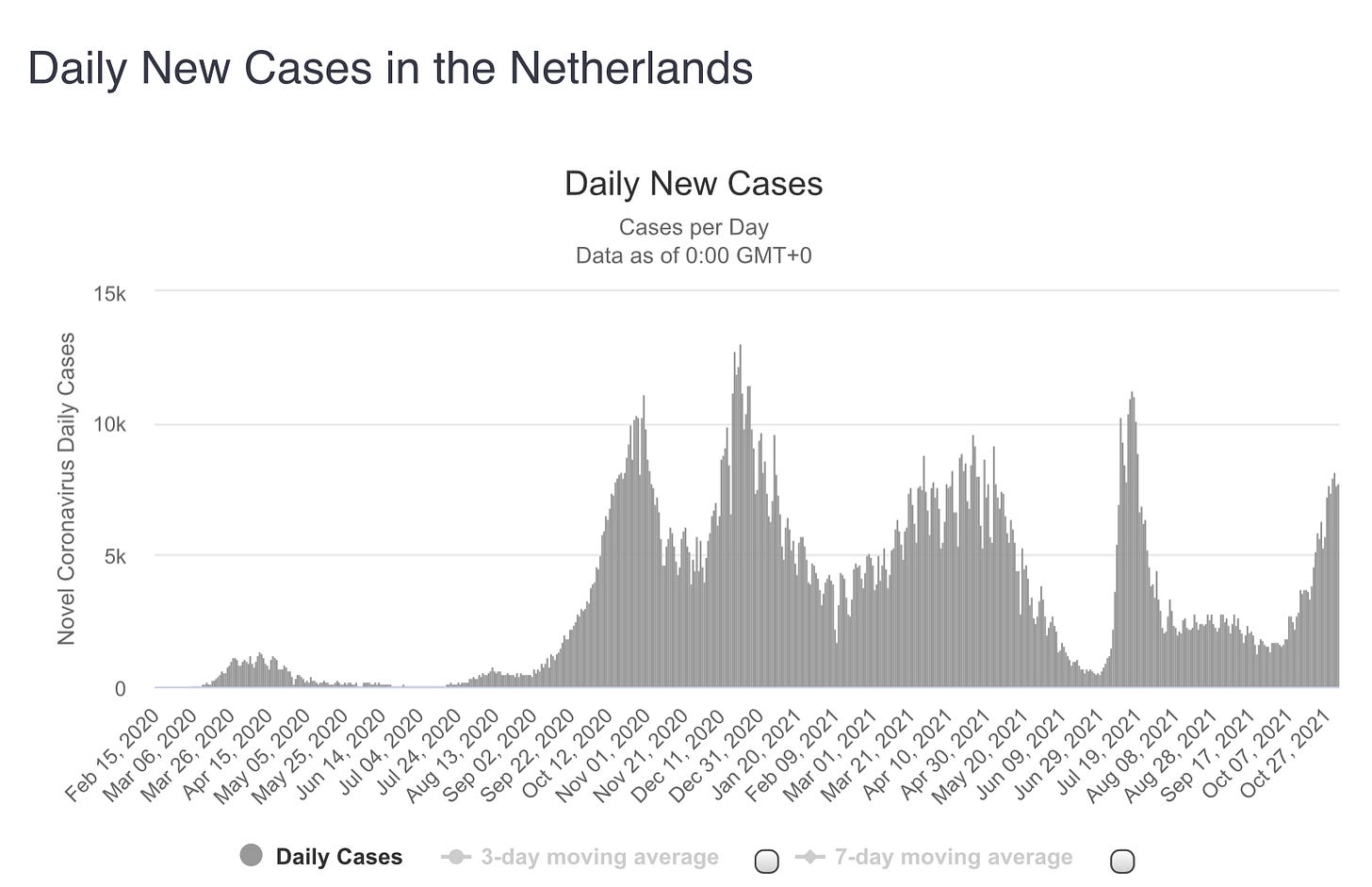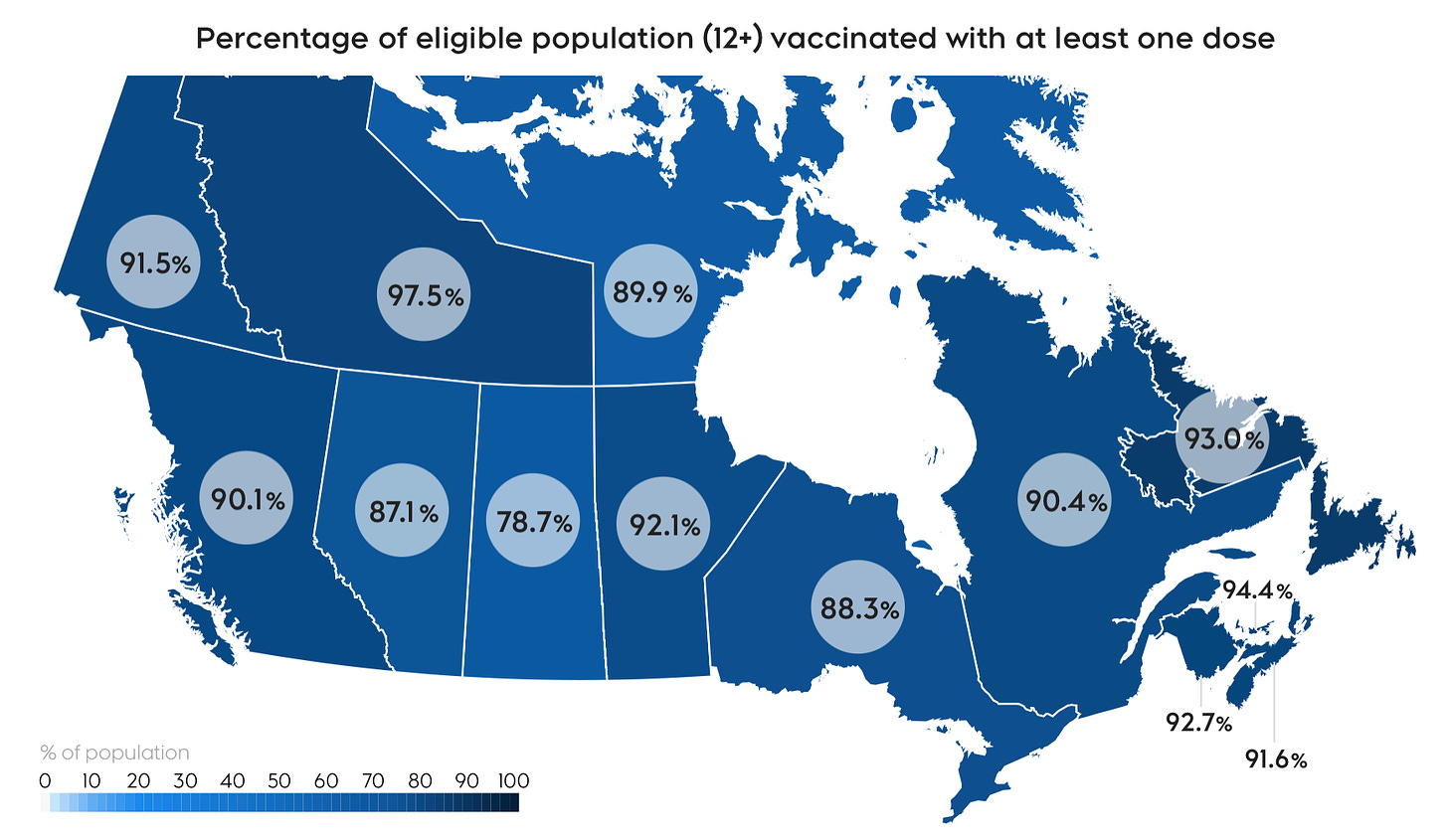🇩🇰
The Delta variant remains absolutely dominant in Denmark. It again made up 100% of all sequenced positive test results last week. This has been the story for just over two months in Denmark minus one week where a single case of the P1 (Gamma) variant was identified.
As for the concerning AY.4.2 sub-variant, it continues to creep upward, going from 253 confirmed cases last week to 330 in this week’s variant update from the Staten Serum Institut. The Delta sub-strain is suspected to be more infectious and epidemiologists in the United Kingdom think it is a possible culprit behind a recent infections surge.
-
It seems concern about the COVID situation in Denmark is rising just as fast as the infection curve is. The latest assessment of the public’s temperament done by the HOPE project found people think authorities should be doing more to protect the public.
The HOPE project has measured public confidence and trust in the path forged by the state during the pandemic. So far, by in large the Danish population has kept faith with the Frederiksen government and the decisions it has made. However, the latest survey shows concerns over the coronavirus situation haven’t been this high since the Alpha variant wave last winter.
It found people think the current rules and recommendations from the health authorities are lacking and more could be done to spur vaccinations, ensure social distancing, and reduce infection spread. It also found the surging numbers are fueling doubts about the vaccines. Although the study noted the anti-vaccine sentiment comes from younger people or those without a lot of education.
-
Denmark remains in its second highest infection wave of the pandemic so far with another 1,978 COVID infections and one more coronavirus death reported today.
Yesterday, there were 163,752 total corona tests done, of which 114,365 were PCR tests equaling a 1.73% positivity percentage, a drop from yesterday’s 2.07%.
-
The number of Danish kommunes with a COVID incidence rate of 100 or more per 100,000 residents has grown to 85. Of those, 13 have an incidence rate of 400 or higher. Albertslund in Metro Copenhagen currently leads all municipalities with an incidence rate of 718.
-
COVID hospitalizations (264) continue to climb (+9) while the number of infected people in an ICU (30) edged downward (-2) and of those the number on a ventilator (15) was unchanged day over day.
-
COVID rapid tests will be made available for staff in all publicly run nursing homes and for those who work in seniors home care. The Danish government, Local Government Denmark, and the Danish Regions reached an agreement Wednesday to reintroduce antigen tests for the seniors care sector.
The plan will see rapid tests made available for all nursing home and senior home care staff “as soon as possible and by no later than November 11.” The tests will be used as a back stop for PCR testing for situations like, for example, when staff get called in on short notice to work.
KL’s chairman Jacob Bundgaard:
“Employees who help the country's senior citizens in nursing homes or in their own homes should have easy access to be tested. The permanent staff already have that access to testing. But more loosely-attached staff such as temporary workers or young workers are often in practice referred to the nationwide network of test stations. Although there are still test opportunities in all municipalities, there can be a long way to go. Therefore, we are pleased that an agreement has now been made that temps and other loosely-affiliated employees can test themselves before their shift begins. This will help keep the infection away from the elderly and most vulnerable citizens.”
Private nursing home operators can also negotiate with the kommune and region to tap into the rapid testing scheme.
Currently, the rules dictate that fully vaccinated seniors care staff get a PCR test at least once a week. Those that are not vaccinated must get tested twice a week. All visitors, regardless of vaccination status, are also encouraged to get tested prior to paying their loved ones a visit.
-
On the vaccination front, the number of 1st doses administered stayed above 1,000 yesterday, which is positive news. Overall on Tuesday, there were just 13,762 total inoculations, with the majority of them, 12,198, being booster shots.
To date, 76.4% of the total population had one vaccine dose and 75.2% have had both doses. While 5.8% have had a 3rd booster shot.
-
Region Nordjylland says 12 new COVID testing centers will open in the region in the days ahead. On Wednesday, new rapid testing centers opened in Frederikshavn, Thisted, and Hobro. This Saturday another site opens at Gammeltorv in Aalborg. A rapid testing site is already up and running at Aalborg Airport.
Health Planning Manager Jacob Bertramsen says the region is “putting the turbo on” in getting more testing facilities open and it won’t just be for rapid tests.
“We are looking at where we can scale up further. For example, work is underway to set up 2 more test sites with PCR testing in the Aalborg area, just as we are looking at it geographically in relation to having good coverage in the entire region.”
-
The number of RS virus infections in Denmark continues to decline as numbers drop for a seventh consecutive week. In week 43 there were 339 confirmed infections.
The caution is that the virus usually only begins to show up in November and peaks in February. This year it has arrived much earlier than ever before, in numbers much higher than ever before. It remains to be seen if there will be a subsequent infection wave(s) through the winter months ahead.
🇫🇴
Due to what is being called a “contagion explosion” by the newspaper Sermitsiaq, the Faroe Islands are leveling new restrictions. All events with more than 50 attendees should be cancelled. Spectators are banned from attending sports games and tournaments. All bars and dance clubs are to close. And schools, kindergartens, and any leisure activities that have outbreaks are to close as well.
These recommendations will remain in place until at least November 12.
As of November 15, the Faroe Islands will introduce a vaccine passport requirement at the border. All incoming travelers must be fully vaccinated or have a recent negative test.
Yesterday there were 76 new infections and 11 people in hospital.
🇸🇪
Sweden has added 1,152 infections and three more corona deaths since yesterday’s update.
So far, 7,258,777 1st doses (85% of population 16 years old and older) and 6,920,306 2nd vaccine doses (81%) have been administered.
Vaccinations data for booster shots and for the 12 to 15 year old age group has still not been updated.
-
Infections are up and hospitalizations are down in Sweden’s capital region. There were 1,618 new infections in the last week, according to Region Stockholm, who says that is an increase from the 1,355 from the previous seven day period. However, there were seven fewer coronavirus patients in hospital week to week.
The positivity percentage is also inching upward, going from 6.3% to 7.7% from one week to the next.
Infection Control Doctor Maria Rotzén Östlund:
“Like last week, we see a certain increase in the number of those found infected. It is still at low levels but still worrying that more people are becoming infected. Now I hope that those who are infected will have a mild illness and avoid having to be cared for at one of our hospitals.”
She says the biggest challenge right now is to get more people vaccinated.
Region Stockholm continues to emphasize there is a backlog in reporting coronavirus deaths. In a recent update, it said there was a two and a half month lag in reporting pandemic deaths.
-
🇳🇴
Norway is seeing a serious infections surge as it added another 1,000 new infections and 17 more corona deaths since yesterday’s update.
COVID hospitalizations (167) are up (+4) while the number of people in an ICU (37) dipped slightly (-1) and of those, the number on a ventilator (17) also fell (-3).
So far, 78.03% of Norwegians 12 years old and older have had one vaccine dose and 69.46% have had both doses.
-
COVID infections are on the rise, especially among unvaccinated children and adolescents, according to the latest weekly assessment of Norway’s pandemic situation. Infections increased by 58% last week compared to the week before, with 6,943 coronavirus cases last week and 4,395 the week prior.
It is not just infections either. Hospitalizations are up as well. There were 105 infected people admitted to hospital last week, up from 79 the week before. COVID deaths are also increasing week to week, with 16 last week, up from 11 in week 42.
Department Director Line Vold:
“High vaccination coverage slows down the spread of the virus. Nevertheless, we see that the virus reaches middle-aged and older people. Among these, we see an increasing number of admissions. The COVID incidence rate in week 43 was more than four times higher among unvaccinated than among fully vaccinated people in the age group 16 years and older. It was also greatest in larger cities. This is not unexpected, as this is where contact frequency is highest.”
Norwegian health authorities are urging municipalities to continue vaccinations “at full force” and for people who are sick to get tested and isolate at home. Municipalities and hospitals are also being warned to prepare for a continued increase in coronavirus infections and a simultaneous increase in other respiratory infections.
-
The Norwegian Public Health Institute has reviewed how the infection situation has played out so far in the new school year and found for some it was a rough start. In Norway, students returned to class in August largely without any rigid restrictions; instead, schools relied on testing in lieu of quarantines.
The report found while many municipalities had very low COVID incidences in schools, that was not the case in the more highly populated regions of Oslo and Viken. The health authority says in those regions coronavirus cases spread rapidly in secondary and upper secondary schools. Conversely, infection rates were much lower in primary schools and kindergartens.
Researcher and Pediatrician Pål Surén:
“Much of the infection spread started even before school began in connection with various activities and gatherings, and many students started school with undetected infections. When the students started school again, the spread of the infection continued both inside the schools and through social activities and events at and outside the school.”
The agency also found that municipalities had a rocky start with not enough time to prepare a problem exacerbated by a lack of rapid tests. But once those issues were ironed out, things began to improve. Infections in the hardest-hit school districts were already dropping when vaccinations began for 12 to 17 year olds.
“The experience from the start of school in the autumn shows that systematic and targeted testing is effective in limiting the spread of infection. This indicates that extensive quarantine use in the event of outbreaks in schools is probably not necessary and that schools can be operated as normal. Infection in schools and kindergartens can be managed with targeted testing and basic infection control measures, even at higher levels of infection. Children and young people rarely get seriously ill and the consequences of infection in these groups are small.”
-
The Norwegian Institute of Public Health says it has not yet reached a definitive yes or no in its study of whether or not COVID vaccines could cause menstrual disorders in women. The institute notes 2,119,631 women have been vaccinated so far and to date there have been 1,264 reports of what it called bleeding disorders.
The agency is in the midst of a study involving more than 60,000 women between the ages of 12 and 80 years old. Some are vaccinated and some are not. So far it says “we do not yet know if there is a connection or not.” That said, the NIPH hopes to conclude its study with a definitive conclusion before the end of the year.
Project Manager Lill Trogstad:
“Even though we ask many questions about different symptoms, it does not mean that we think the vaccine can cause all of these. There is generally little knowledge about how common or unusual bleeding disorders are in women of different ages. Therefore, we ask lots of questions to find out more. The information that is collected is crucial to finding answers to these questions that women and health authorities now ask, and not least to clarify whether there may be a connection with vaccination.”
🇫🇮
Finland is also seeing a major COVID surge as it reports 1,150 infections and another six virus deaths in the last day.
COVID hospitalizations (238) are up (+12).
To date, 4,232,475 1st doses (75.4% of the total population) and 3,884,825 2nd vaccine doses (69.5%) have been administered.
🇳🇱
The Netherlands decided today to reintroduce COVID restrictions to try and slow the spread of the virus. Among the re-imposed measures will be mandatory face mask use and expanded application of the vaccine passport system to include museums, gyms, and restaurant patios.
The Netherlands reported 9,195 new infections today, with 53,210 corona tests done in the last day. That equals a positivity percentage of 17.28%, which is not good.
🇪🇺🦠
Pharmaceutical company Eli Lilly has withdrawn its two antibodies bamlanivimab and etesevimab, used to treat COVID patients, from a rolling review being conducted by the European Medicines Agency.
In a letter to the EMA, the company says:
“At this point, Lilly is not in a position to generate the additional data required by the CHMP to progress to a formal marketing authorization application.”
For its part Europe’s pharmaceutical watchdog says there were some questions about the medicine’s quality that “remained to be satisfactorily addressed.”
🌏💉
Another COVID vaccine has joined the fight, at least in the eyes of the World Health Organization. The WHO has granted an emergency use listing to Covaxin, a vaccine developed by India’s Bharat Biotech.
The WHO’s Technical Advisory Group determined Covaxin meets the World Health Organization’s standards for vaccine efficacy ruling its benefits outweigh any risks.
“Covaxin was found to have 78% efficacy against COVID of any severity, 14 or more days after the second dose, and is extremely suitable for low- and middle-income countries due to easy storage requirements.”
Covaxin is a two dose vaccine with the second to be administered four weeks after the first. The WHO specifies it is only to be used on adults 18 years old and older. It also notes studies are “insufficient” to determine the vaccine’s safety for pregnant women.
Covaxin is currently not authorized for use in Europe and as of this writing Bharat Biotech has not even applied for a rolling review by the European Medicines Agency.
🇺🇸 💉
Yesterday, the US Food and Drug Administration approved the use of the Pfizer/BioNTech vaccine for children aged five to 11 years old. The vote officially green-lights the beginning of an effort across the United States to vaccinate young children, which could start as early as today.
🇨🇦
Canada reported 1,839 new COVID infections yesterday and another 33 virus deaths.
The vaccination effort in Canada has so far administered 29,775,209 1st doses (77.87% of the total population) while 28,319,554 people (74.06%) are fully vaccinated. To date, there have been 464,698 booster shots done.
In Ontario today there were 378 new infections, of which 236 are among people who are unvaccinated or who have a single dose. There are 237 people in a hospital; of those 174 either have one dose or none at all. Of the 137 people in intensive care that number 125. Ontario has expanded its booster shot campaign to open the door for a third dose to seniors 70 years old and older, healthcare staff, essential caregivers, First Nations people, and anyone who has two doses of AstraZeneca.
Quebec reported 525 infections and another eight deaths.
In Atlantic Canada, New Brunswick has 60 infections and one death. Newfoundland and Labrador had one. Nova Scotia has 38.
Manitoba saw 128 corona cases and two more fatalities.
There were 173 infections reported in Saskatchewan today.
Alberta logged 487 new cases and 14 more deaths today . The province has 532 people in hospital, of which 73.8% are either unvaccinated or have a single dose. Of the additional 159 people in an ICU that number is 88.6%.
B.C. registered 406 infections yesterday and five more deaths. There are 445 people hospitalized and 137 in an ICU. Of those in intensive care, 88% are unvaccinated.




